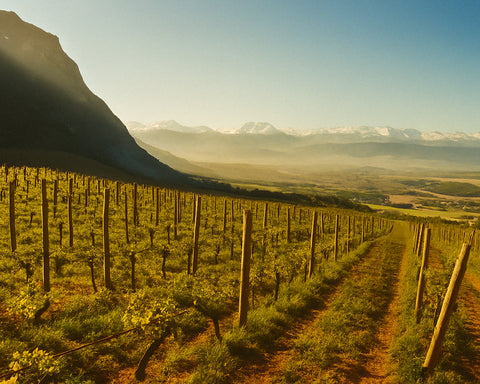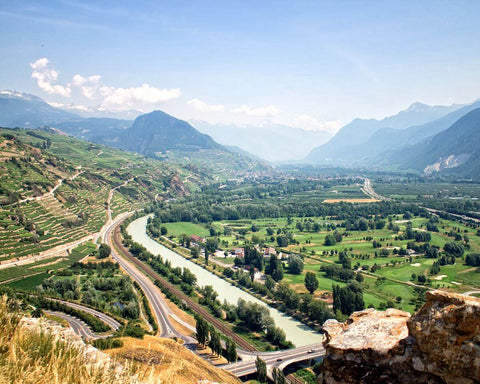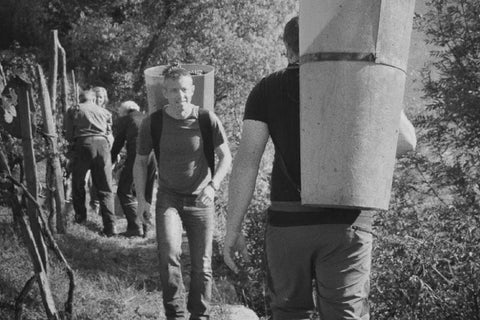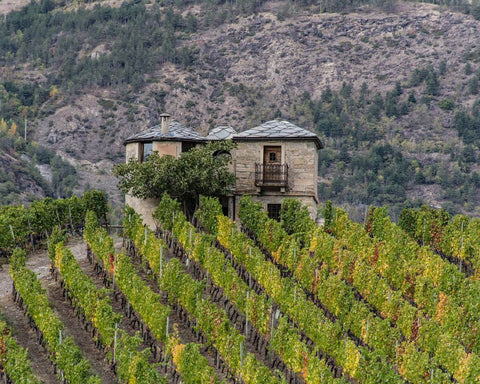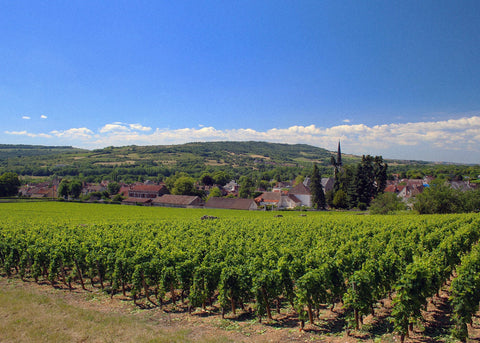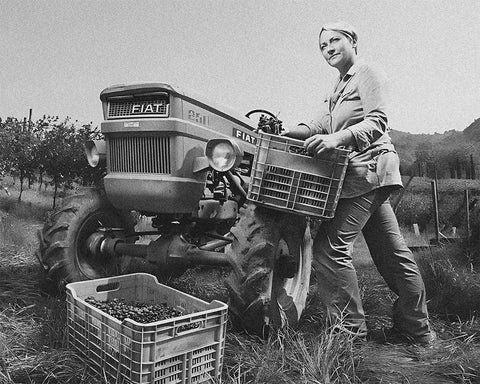Savoie, nestled in the heart of the French Alps, represents one of France's most distinctive and dramatically beautiful viticultural landscapes. Bordered by Switzerland to the east and Italy to the southeast, this mountainous region creates wines that capture the essence of high-altitude terroir while maintaining a culinary tradition deeply rooted in Alpine heritage. Savoie's wines, influenced by glacial soils and alpine climate, are celebrated for their purity, minerality, and remarkable food-pairing versatility.
Over the centuries, Savoie has evolved from a strategic Alpine crossroads into a unique wine region that emphasizes indigenous grape varieties and traditional winemaking methods. The region's commitment to preserving ancient viticultural practices, combined with its exceptional terroir, produces wines that are both distinctly Alpine and surprisingly elegant. To many wine enthusiasts seeking authenticity beyond the mainstream, Savoie represents the soul of mountain viticulture.
Table of Contents
History of Savoie
The Savoie region's viticultural history spans over two millennia, with its strategic position along ancient trade routes between France, Switzerland, and Italy shaping both its wine culture and culinary traditions. This Alpine crossroads has been influenced by Celtic tribes, Romans, and various European dynasties, each contributing to the region's unique identity.
Viticulture in Savoie began during the Roman occupation, when soldiers and settlers recognized the potential of the region's south-facing slopes and diverse microclimates. The Romans established the foundations of what would become a thriving wine culture, particularly around Lac du Bourget and the Isère Valley, where favorable conditions allowed for successful grape cultivation despite the challenging Alpine environment.
During the medieval period, Savoie came under the rule of the House of Savoy, a powerful dynasty that controlled territories spanning modern-day France, Italy, and Switzerland. This period saw significant development of monastic viticulture, with Cistercian and Benedictine monks cultivating vineyards and developing winemaking techniques suited to the Alpine climate. The monks' meticulous record-keeping and experimentation with indigenous grape varieties laid the groundwork for Savoie's modern wine identity.
The 19th century brought both challenges and opportunities to Savoie's wine industry. The region's incorporation into France in 1860 opened new markets, while the arrival of the railway connected Alpine vineyards to broader European commerce. However, phylloxera devastated many vineyards, leading to a period of reconstruction that emphasized quality over quantity and the preservation of native grape varieties.
The 20th century saw Savoie's wine industry modernize while maintaining its artisanal character. The establishment of AOC (Appellation d'Origine Contrôlée) status in 1973 for Vin de Savoie and subsequent recognition of specific crus helped protect and promote the region's unique wine heritage. Today, Savoie continues to balance tradition with innovation, producing wines that reflect both ancient Alpine wisdom and contemporary winemaking excellence.
Terroir of Savoie
Savoie's terroir is among the most dramatically diverse in France, characterized by extreme variations in altitude, exposure, and soil composition that create a patchwork of distinct microclimates. The region's mountainous landscape, ranging from 200 to 500 meters in elevation, combined with the moderating influence of alpine lakes, creates ideal conditions for producing elegant, mineral-driven wines.
The region benefits from a continental climate with alpine influences, featuring cold winters, warm summers, and significant diurnal temperature variation. This climate, combined with the protective effect of surrounding mountains and the thermal regulation provided by Lac du Bourget and Lac d'Annecy, creates growing conditions that preserve acidity while allowing for proper ripening of indigenous grape varieties.
The Geology of Savoie
Savoie's geological complexity reflects its tumultuous Alpine formation, providing diverse soil types that contribute to the distinctive character of its wines.
- Glacial Moraines: Ancient glacial deposits create well-draining soils rich in limestone and schist, ideal for producing mineral-driven white wines with exceptional aging potential.
- Limestone Slopes: Steep limestone escarpments provide excellent drainage and heat retention, perfect for cultivating Altesse and Jacquère while imparting characteristic mineral complexity.
- Schistose Terraces: Decomposed schist soils on terraced hillsides offer ideal conditions for red varieties like Mondeuse, contributing structure and earthy complexity to the wines.
- Alluvial Plains: River valley floors with deeper, more fertile soils support higher-yielding vineyard sites while maintaining the freshness characteristic of Alpine wines.
The diverse terroir of Savoie allows for the cultivation of numerous indigenous grape varieties, each expressing unique characteristics that reflect their specific growing environment and the region's Alpine identity.
Climate and its Influence
Savoie's climate is distinctly continental with pronounced alpine characteristics, featuring cold winters, warm summers, and dramatic diurnal temperature swings. The region's varied topography and the moderating influence of alpine lakes create numerous microclimates that contribute to the complexity and distinctiveness of Savoie wines.
The Grapes of Savoie
Savoie is renowned for its commitment to indigenous grape varieties, many of which are found nowhere else in the world. These ancient cultivars have adapted perfectly to Alpine conditions, producing wines of remarkable character and authenticity.
White Grape Varietals
- Jacquère: The region's most widely planted variety, known for its crisp acidity, mineral character, and ability to express terroir with remarkable precision.
- Altesse (Roussette): A noble variety producing complex, age-worthy wines with honeyed notes and exceptional mineral depth.
- Chasselas: Traditionally grown around Lac Léman, creating delicate wines with floral aromatics and subtle fruit character.
- Chardonnay: While not indigenous, Chardonnay thrives in Savoie's climate, producing wines with pronounced minerality and alpine freshness.
Red Grape Varietals
- Mondeuse: Savoie's signature red variety, known for its deep color, spicy character, and ability to produce both fresh, fruity wines and age-worthy, complex bottlings.
- Gamay: Producing light, fresh reds perfect for the Alpine lifestyle and local cuisine.
- Pinot Noir: Thriving in cooler sites, creating elegant wines with characteristic Burgundian finesse adapted to Alpine conditions.
Top Wines of Savoie
Roussette de Savoie: The pinnacle of Savoie white wine production, made exclusively from Altesse grapes. These wines showcase remarkable complexity, with honeyed aromatics, mineral depth, and exceptional aging potential. The finest examples come from specific crus like Frangy and Monterminod.
Apremont: Perhaps Savoie's most famous wine, this Jacquère-based white from glacial soils exhibits pristine minerality, citrus precision, and a distinctive salinity that perfectly captures Alpine terroir.
Chignin-Bergeron: Made from Roussanne grown on steep limestone slopes, this wine represents Savoie's most ambitious white wine project, producing age-worthy bottles with remarkable depth and complexity.
Arbin Mondeuse: The region's most celebrated red wine, showcasing Mondeuse at its finest from steep, south-facing slopes. These wines combine rustic mountain character with surprising elegance and aging potential.
Other Notable Wines: Savoie also produces exceptional wines from specific crus including Ayse (known for sparkling wines), Crépy (elegant Chasselas), and Jongieux (diverse varieties on limestone soils), each reflecting unique terroir characteristics.
Cuisine and Typical Products of Savoie
Savoie's cuisine reflects the region's Alpine environment and cross-cultural influences, creating a distinctive culinary tradition built around hearty mountain fare, exceptional dairy products, and ingenious preservation techniques. The cuisine is renowned for its comfort-food philosophy, emphasizing rich flavors, local ingredients, and dishes designed to sustain mountain dwellers through harsh Alpine winters.
Cheese plays a central role in Savoyard cooking, with dishes like "fondue savoyarde" and "raclette" exemplifying the region's mastery of dairy-based cuisine. The mountainous terrain yields exceptional cheeses, cured meats, and alpine herbs that form the foundation of traditional Savoyard gastronomy.
Among the region's most prized products are its mountain cheeses, particularly "Reblochon," "Beaufort," and "Tomme de Savoie," along with cured meats like "jambon de Savoie." These ingredients appear in countless preparations, from simple mountain fare to sophisticated modern interpretations.
Savoie Antipasti
In Savoie, meals often begin with mountain-inspired appetizers that highlight the region's preserved and cured specialties:
- Charcuterie Savoyarde: Local cured meats including jambon de Savoie, saucisson sec, and bresaola served with pickled vegetables.
- Tartines au Reblochon: Grilled bread topped with melted Reblochon cheese and herbs.
- Terrine de Gibier: Game terrines featuring local venison or wild boar with juniper and mountain herbs.
- Crozets: Small square pasta unique to Savoie, often served as a starter with cheese or mushrooms.
Savoie First Courses
First courses in Savoie emphasize warming soups and preparations that showcase local dairy and mountain products:
- Soupe aux Choux: Hearty cabbage soup with local sausage and mountain vegetables.
- Fondue Savoyarde: The iconic cheese fondue made with Gruyère, Comté, and white wine.
- Tartiflette: Creamy potato gratin with Reblochon cheese, lardons, and onions.
- Soupe d'Orties: Nettle soup, a traditional mountain dish rich in minerals and flavor.
Savoie Second Courses
Main courses feature game, mountain fish, and hearty preparations suited to Alpine life:
- Diots au Vin Blanc: Traditional Savoyard sausages cooked in white wine with onions.
- Féra du Lac: Lake fish prepared simply to highlight its delicate flavor.
- Gigot de Chevreuil: Venison leg with juniper and mountain herb crust.
- Omble Chevalier: Arctic char from alpine lakes, often grilled or poached.
Savoie Side Dishes
Savoie's side dishes celebrate mountain vegetables and traditional preservation methods:
- Gratin Dauphinois: Creamy potato gratin with milk and cheese.
- Crozets au Beaufort: Traditional square pasta with Beaufort cheese.
- Légumes d'Automne: Roasted root vegetables with mountain herbs.
Savoie Cheeses
Savoie's cheese-making tradition represents one of France's most important alpine dairy cultures:
- Reblochon: Soft-ripened cheese with a washed rind and creamy, nutty interior.
- Beaufort: Hard mountain cheese aged in alpine caves, known as the "Prince of Gruyères."
- Tomme de Savoie: Semi-hard cheese with a natural rind and fruity, complex flavor.
- Abondance: Firm cheese with a distinctive concave wheel shape and fruity aroma.
Savoie Desserts
Savoyard desserts often incorporate local dairy products, mountain honey, and preserved fruits:
- Tarte aux Myrtilles: Wild blueberry tart showcasing mountain berries.
- Rissoles: Fried pastries filled with jam or apple compote.
- Gâteau de Savoie: Light sponge cake traditional to the region.
- Tome Blanche: Fresh cheese dessert served with mountain honey and nuts.
Typical Products of Savoie
Savoie's culinary identity is built upon exceptional local products, many protected by AOC status, ensuring traditional production methods and regional authenticity.
Reblochon de Savoie
Reblochon represents the pinnacle of Savoyard cheese-making, with its creamy texture and complex, nutty flavor. This AOC cheese is essential to dishes like tartiflette and embodies the region's dairy excellence.
Jambon de Savoie
Jambon de Savoie showcases traditional Alpine curing methods, creating a delicate, aromatic ham that reflects the mountain environment where it's produced.
Diots de Savoie
These traditional pork sausages, often flavored with white wine and herbs, represent authentic Savoyard charcuterie traditions and pair perfectly with local white wines.
Génépi
This alpine liqueur, made from artemisia plants growing at high altitude, captures the essence of Savoie's mountain terroir in liquid form, traditionally consumed as a digestif after hearty mountain meals.
More on Savoie's History
- Ancient Alpine Settlements
- Medieval Duchy Period
- House of Savoy Influence
- French Integration
- Modern Savoie
Ancient Alpine Settlements
Savoie's history begins with Celtic tribes who recognized the strategic value of Alpine passes and established early settlements that would later become important trade centers connecting northern and southern Europe.
Medieval Duchy Period
The medieval period saw Savoie emerge as a powerful independent duchy, with monastic communities developing viticulture and establishing the agricultural foundations that continue to define the region today.
House of Savoy Influence
Under the House of Savoy, the region developed its unique cultural identity, balancing French, Italian, and Swiss influences while establishing trade relationships that promoted local wine and food products throughout Europe.
French Integration
The 1860 incorporation into France brought new opportunities for Savoie's wine industry, connecting Alpine producers to broader French and international markets while preserving regional traditions.
Modern Savoie
Today's Savoie successfully balances tourism, traditional agriculture, and modern industry while maintaining its commitment to indigenous grape varieties and artisanal food production that defines its cultural heritage.
